
In biology, a type is a particular specimen of an organism to which the scientific name of that organism is formally associated. In other words, a type is an example that serves to anchor or centralizes the defining features of that particular taxon. In older usage, a type was a taxon rather than a specimen.
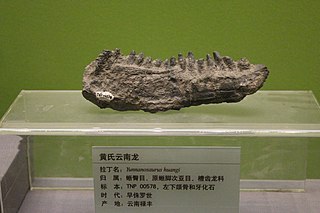
Yunnanosaurus is an extinct genus of sauropodomorph dinosaur that lived approximately 199 to 183 million years ago in what is now the Yunnan Province, in China, for which it was named. Yunnanosaurus was a large sized, moderately-built, ground-dwelling, quadrupedal herbivore, that could also walk bipedally, and ranged in size from 7 meters (23 feet) long and 2 m (6.5 ft) high to 4 m (13 ft) high in the largest species.

Revueltosaurus is an extinct genus of suchian pseudosuchian from Late Triassic deposits of New Mexico, Arizona and North Carolina, United States. Many specimens, mostly teeth, have been assigned to Revueltosaurus over the years. Currently, three species are included in this genus, all of which were originally thought to represent monospecific genera of basal ornithischian dinosaurs. Revueltosaurus was about 1 meter long.
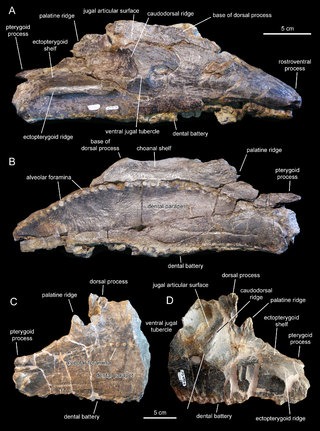
Pararhabdodon is a genus of tsintaosaurin hadrosaurid dinosaur, from the Maastrichtian-age Upper Cretaceous Tremp Group of Spain. The first remains were discovered from the Sant Romà d’Abella fossil locality and assigned to the genus Rhabdodon, and later named as the distinct species Pararhabdodon isonensis in 1993. Known material includes assorted postcranial remains, mostly vertebrae, as well as maxillae from the skull. Specimens from other sites, including remains from France, a maxilla previously considered the distinct taxon Koutalisaurus kohlerorum, an additional maxilla from another locality, the material assigned to the genera Blasisaurus and Arenysaurus, and the extensive Basturs Poble bonebed have been considered at different times to belong to the species, but all of these assignments have more recently been questioned. It was one of the last non-avian dinosaurs known from the fossil record that went extinct during the Cretaceous-Paleogene extinction event.
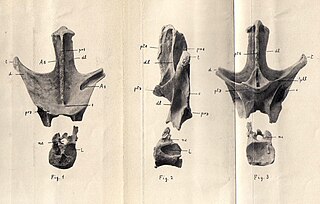
Nopcsaspondylus is a genus of rebbachisaurid sauropod dinosaur from the Cenomanian-age Candeleros Formation of Neuquén, Argentina. It is based on a now-lost back vertebra described by Nopcsa in 1902 but not named at the time. The specimen had a small vertebral body and large hollows, now known to be typical of rebbachisaurids.

Nepenthes pitopangii is a tropical pitcher plant endemic to the Indonesian island of Sulawesi. Discovered in 2006, N. pitopangii was initially known from a single plant at a remote locality in Lore Lindu National Park. Efforts made in the following years to locate further populations on surrounding mountains proved unsuccessful. In March 2011, a new population of N. pitopangii consisting of around a dozen plants was discovered more than 100 km from the type locality. Nepenthes pitopangii appears to be closely related to N. glabrata, from which it differs most obviously in its upper pitcher morphology.
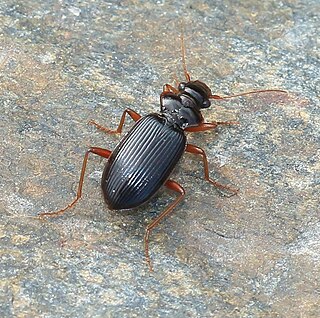
Leistus is a genus of ground beetles in the family Carabidae. There are more than 250 described species in Leistus, found in the Holarctic.

Leistus terminatus is a species of ground beetle that is native to the Palearctic realm and Europe, where it can be found in countries like Austria, the Baltic states, Benelux, Great Britain including the Isle of Man, the Czech Republic, mainland France, Germany, Hungary, the Republic of Ireland, mainland Italy, North Macedonia, Northern Ireland, mainland Poland, Romania, Scandinavia, Slovakia, Slovenia, Switzerland, and eastern Europe.
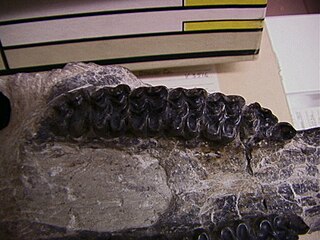
Scaphohippus is an extinct Miocene genus of equine, with two known species, known from fossils found in California, New Mexico, Montana, and Nebraska.
Itilochelys is an extinct genus of sea turtle in the family Cheloniidae containing the single species Itilochelys rasstrigin. The species is known only from the Early Paleocene, Danian stage Rasstrigin 2 locality, Dubovsky District, Volgograd Oblast, Russia.

Adelolophus is a genus of lambeosaurine dinosaur from Upper Cretaceous rocks in the U.S. state of Utah. The type and only known species is A. hutchisoni; the type specimen consists only of a broken maxilla. It constitutes the oldest known lambeosaur remains from North America, as well as the only known lambeosaur species from the Wahweap Formation, of which it pertains to the Upper Member. Among its relatives, it seems to be particularly similar to Parasaurolophus, rather than animals like Lambeosaurus; phylogenetic analysis confirms this, finding it in Parasaurolophini. It would have lived in a wet environment, bordering on the sea but with a more arid season during some times of the year. This environment would have been shared with a diverse variety of fish and turtles, as well as other dinosaurs like ceratopsids and tyrannosaurids.
Peripatopsis sedgwicki is a species of velvet worm in the Peripatopsidae family. Also known as the Tsitsikamma velvet worm, this species has a narrow geographic distribution in South Africa but is especially abundant in the indigenous forest of the Tsitsikamma mountains. Recent phylogenetic analysis using molecular data finds that Peripatopsis sedgwicki as traditionally understood based on morphology is a species complex that contains four different species: P. sedgwicki s.s., P. orientalis, P. collarium, and P. margaritarius.

Sibirotitan is a genus of somphospondyl sauropod from the Ilek Formation of Russia. The type and only species is S. astrosacralis.

Weewarrasaurus is a genus of ornithopod dinosaur from the Late Cretaceous of the Griman Creek Formation near Lightning Ridge, in New South Wales, Australia. The type and only species is W. pobeni, known from the holotype, an isolated dentary preserved in opal, as well as a secondary referred dentary. It is thought to have co-existed with multiple other ornithopods of different sizes and lineages.

Brodiechelys is an extinct genus of terrestrial turtle belonging to the family Xinjiangchelyidae. Remains of Brodiechelys dated back to the Early Cretaceous period, and have been found in the United Kingdom and Spain.

Ictidosaurus was a therapsid genus found in the Abrahamskraal Formation of South Africa, which lived during the middle Permian period. Fossils of the type species were found in the Tapinocephalus, and the base of the Eodicynodon assembly zones, of the Karoo Basin. Older classifications of the species, along with many other specimens found in the Iziko South African Museum archives, were originally classified within therocephalian family names, in this case the Ictidosauridae, which has been reclassified as belonging to the Scylacosauridae. The type species is I. angusticeps.
Leistus darvazicus is a species of ground beetle that can be found in the Darvazskiy Mountain Range, Tajikistan. It belongs to the subgenus Pogonophorus.
Leistus schuelkei is a species of ground beetle that can be found in Turkey. It is in the subgenus Leistus.
Leistus trabzonicus is a species of ground beetle found south of Uzongöl, Trabzon Province, Turkey. It belongs to the subgenus Leistus.
Leistus rezabkovae is a species of ground beetle found in the Gansu Province, China. It belongs to the subgenus Evanoleistus.













